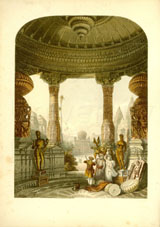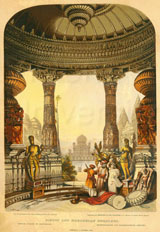Advances in paper-making, printing techniques, and trade bindings in the first half of the nineteenth century influenced the type of literature being published and the cost at which it was produced. The introduction of technologies like steel engraving and dual-colour printing gave unprecedented numbers of people access to reproductions of works by prominent artists. The popular genre of annuals and gift books, which combined literary pieces with lavish engravings, fuelled public demand for increasingly impressive illustrations. The artist, engraver, and printer George Baxter was instrumental in revolutionizing colour printing in the late 1820s. Using wood and metal colour blocks in conjunction with steel key plates, he was able to produce elaborate coloured prints at a low cost.
By 1834, Baxter’s prints had begun to be used as frontispieces to gift books. His “Hindoo and Mahomedan Buildings” appeared in Fisher’s Drawing Room Scrap-Book, The Parlour Table Book, Gallery of Modern British Artists, and Emma Roberts’ Views in India. Slight variations in the images from one version to another may be interesting, but perhaps more evocative are the diverse texts in which the prints were bound. Rather than being simply slotted into a volume, engravings such as Baxter’s often formed the foundation of the literary works of which they were a part. Specifically, as the genre of annuals and gift books developed, there was an inversion of traditional text-image relationships; editors of annuals, eager to include pleasing prints regardless of topic, commissioned authors like L.E.L to write pieces “illustrating” the images in a volume.
Engraved and printed by George Baxter from a drawing by D. Roberts.
Letitia Elizabeth Landon. Fisher’s Drawing Room Scrap-Book, 1835.
London: H. Fisher, R. Fisher, & P. Jackson, 1834.
Engraved and printed by George Baxter from a drawing by D. Roberts.
Hindoo and Mahomedan Buildings.
London: Fisher & Co., 1835.





